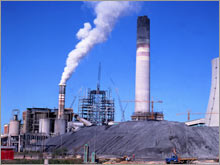Making money on clean coalAs global warming takes the spotlight and electricity use soars, several companies are poised to cash in on the demand for clean coal.NEW YORK (CNNMoney.com) -- With global warming on everyone's mind, combined with a slew of electronic gadgets consuming more and more electricity, there's a greater need than ever for clean coal technology in the United States. That was only reinforced Monday, when the Supreme Court ruled the Environmental Protection Agency has the authority to start regulating heat-trapping gasses. The ruling is likely to quicken legislation in Congress aimed at regulating carbon dioxide, one of the main greenhouse gases.
Since coal-fired power plants are one of the biggest sources of carbon emissions, companies peddling clean coal technology stand to make lots of money. The process everyone is most excited about involves coal gasification, which uses a combination of heat, steam and pressure to turn the coal into a gas. The gas, also known as syn-gas, is composed of hydrogen and carbon dioxide. The greenhouse gas carbon dioxide can then be separated, and the clean burning hydrogen burned to make electricity. "We think this is the next generation of power plants," said John Grasser, a spokesman at the Energy Department. Striping out the carbon dioxide means the greenhouse gas isn't released into the air. But it also means the leftover carbon dioxide needs to be disposed of. "That's where things are happening," said Jason Hayes, a spokesman for the American Coal Council. "Right now we get half our power from coal, and we're trying to figure out what to do with the carbon." It's theoretically possible to inject that carbon back into the ground, a technique called carbon sequestration. Duke Energy (Charts, Fortune 500) is one of the first utilities to begin experimenting with this technology. With the help of $134 million in tax incentives from the Department of Energy, and an additional $75 million in state incentives, Duke is planning on building a 600 megawatt integrated gasification combined cycle (IGCC) plant in Indiana. The plant, which is set to be built by General Electric (Charts, Fortune 500) and Betchel, is expected to cost between $1.6 to $2.1 billion, or 30 percent more than a conventional coal-fired power plant, according to Duke spokesman Tom Williams. "We're doing it because we have to meet load, and we want a diverse mix of plants," said Williams. Eventually, Williams said it's hoped the carbon captured from the Illinois plant can be injected into the ground right on site, although he said that technology is still unproven on a commercial scale. Other companies experimenting with IGCC technology include ConocoPhillips (Charts, Fortune 500), Royal Dutch Shell (Charts), Siemens (Charts) and Mitsubishi. A more conventional technology for cleaning up coal involves burning it at higher temperatures. Known as supercritical technology, the process burns coal more efficiently and generates steam at much higher temperatures and pressure than in older coal plants. The steam turns a turbine to produce electricity. Supercritical technology doesn't remove carbon from the process, but greater efficiency means less coal is burned to create the same amount of power. Most companies that make boilers for coal-fired power plants are involved in supercritical technology, including Paris-based Alstom and Babcock & Wilcox, a subsidary of the construction and engineering giant McDermott International (Charts). Most new coal-fired plants will use supercritical technology, and the power plant construction boom in Asia has kept these firms quite busy. "Most of these companies are fully loaded with orders," said Rich Chapman, a project director at Black & Veatch, an engineering and construction firm that builds power plants, including IGCC plants. "If anyone has to do something on short order, it's pretty hard." There are also specialty companies that clean coal before it even gets to the power plant. Utah-based Headwaters uses air and water to clean coal that was originally too dirty to burn. The company is also working on an experimental program to clean acid rain, mercury and smog-causing agents from coal, usually by heating it before it goes to the utility. And while not directly related to greenhouse gases, scrubbers for removing acid rain-causing sulfur dioxide at the smoke stack are also in high demand as federal clean air rules tighten. The devices are made by firms including Japan-based Chiyoda, Alstom, Babcock & Wilcox, Hitachi (Charts) and Mitsubishi. "There's going to be a whole lot of scrubbing going on," said Duke's Williams. _________________ |
Sponsors
|


